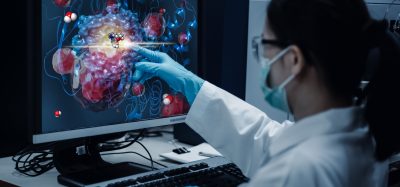The effectiveness of nanoparticles in chemotherapy
Posted: 24 November 2023 | Ellen Capon (Drug Target Review) | No comments yet
Understanding more about the effect of liposome nanoparticles on the immune system will improve drug delivery systems.


Researchers have explored systems that can deliver drugs directly to tumours in hope to reduce chemotherapy side effects. The use of nanoparticles, which are around the size of a virus particle, is a very promising delivery method for overcoming chemotherapy issues. Therapeutic and diagnostic nanoparticles typically fall into two categories: inorganic nanoparticles (eg, gold, silica, iron oxide, etc) and organic nanoparticles (eg, polymeric, liposomes, micelles, etc).1
Dr Ninh (Irene) La-Beck, from the Department of Immunotherapeutics and Biotechnology at the Texas Tech University Health Sciences Center (TTUHSC) Jerry H. Hodge School of Pharmacy, recently received a five year, $2.49 million grant from the National Cancer Institute. The grant will enable her to investigate the interaction of nanoparticles with the immune system and cancer, supporting the development of new drug delivery systems.
Liposomes
One nanoparticle delivery system utilises liposomes. Liposomes are artificial orb-like sacs usually created from cholesterol and natural non-toxic phospholipids, lipids whose molecules include a group of phosphates.
La-Beck explained: “The thing that’s really attractive with using a nanoparticle in cancer treatments is that the nanoparticle is much larger than chemotherapy molecules.” She continued: “Because it’s larger, it is less likely to leak out and go to other healthy tissues, so it potentially causes fewer side effects.”2
Tumour blood vessels leak and grow rapidly with the tumour, unlike typical blood vessels. Most tumour vessels have an irregular diameter and an abnormal branching pattern and do not fit well into the usual classification of arterioles, capillaries, or venules. Even large-calibre vessels have thin, leaky walls.3 The leakiness provides the nanoparticles an entrance to the tumour, bypassing normal tissue. La Beck noted: “Every time the heart pumps, more of the drug leaks out from the blood vessels and into the tumour tissue where it accumulates over time.” She added: “This means the concentration of the chemotherapy increases, and we think that helps the drug to work better.”2
Efficacy issues
Drug delivery via liposomes increases drug accumulation in the tumour while sparing healthy tissue. There are several liposomal chemotherapies approved to treat cancer, and nearly all of them have been shown to produce better safety profiles. Doxorubicin, a drug frequently used for breast cancer treatment, causes significant heart toxicity. This therefore limits the maximum dose a patient can receive, but La-Beck said when doxorubicin is put into a nanoparticle there is very little heart toxicity.
However, La-Beck noted: “The problem is that we don’t actually see the improvement in efficacy that we anticipated; we see better safer, but we don’t see better efficacy. Why is that if we’re supposedly getting more of the chemo into the tumour?”2
Previously, La-Beck’s research has shown that liposomes made of phospholipids and cholesterol, like those used in patients, doubled tumour size in mice by suppressing their immune response in some tumours. Macrophages were detected as the cells responsible for these negative effects.
Preliminary data generated by La-Beck demonstrates that liposomal cholesterol is metabolised into oxysterols that alter macrophage functions. Based on this, La-Beck theorised that: “liposomal oxysterols cause macrophages to suppress antitimour activity and enhance tumour growth.”2
Nanoparticles and the immune system
The immune system responds to liposomes in the same way it would to any other pathogen. Macrophages typically consume and clear pathogens and then present the pathogen parts to T cells. The T cells then give an antigen-specific response to recognise that specific pathogen.
“they stimulated molecules to be released that actually can suppress certain parts of the immune system and promote tumour cell growth.”
The macrophages are vital in the initial clearing of nanoparticles and in activating other immune responses to the nanoparticles. Some of these responses are beneficial, as they cause the immune cells to produce molecules that aid in activating an immune response against cancer cells. On the other hand, some of these responses were bad. La-Beck said: “they stimulated molecules to be released that actually can suppress certain parts of the immune system and promote tumour cell growth.”2
With her grant, La-Beck’s research will concentrate on the cholesterol part of the liposome delivery system. When too much cholesterol is metabolised too much in the wrong way, it causes other diseases like atherosclerosis and may have a role in the pathogenesis of Alzheimer’s disease and other cancers.
La-Beck concluded: “The bottom line is these nanoparticles delivery systems have a huge potential to help make treatments better, but there’s a lot we don’t understand about how they affect the immune system.”
“If we don’t figure that out, then we can’t fully exploit their therapeutic potential.”2
References
1 Anselmo AC, Mitragotri S. Nanoparticles in the clinic. Bioengineering & Translational Medicine. 2016 March 31 [2023 November 20]; 1(1):10-29. Available from: https://aiche.onlinelibrary.wiley.com/doi/full/10.1002/btm2.10003
2 Eurekalert. TTUHSC’s La-Beck to study cancer drug delivery via nanoparticles. Eurekalert [Internet]. 2023 November 17 [2023 November 20]. Available from: https://www.eurekalert.org/news-releases/1008543
3 Baluk P, McDonald DM. Significance of Blood Vessel Leakiness in Cancer. Cancer Research. 2002 September 15 [2023 November 21]; 62(18):5381-5. Available from: https://aacrjournals.org/cancerres/article/62/18/5381/509091/Significance-of-Blood-Vessel-Leakiness-in-Cancer1
Related topics
Cancer research, Chemotherapy, Drug Discovery, Immunotherapy, Small Molecules
Related conditions
Cancer
Related organisations
National Cancer Institute, Texas Tech University Health Sciences Center








